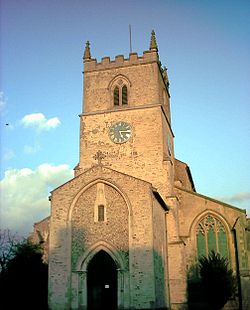Bottisham
| Bottisham | |
| Cambridgeshire | |
|---|---|

| |
| Location | |
| Grid reference: | TL543607 |
| Location: | 52°13’16"N, -0°15’40"E |
| Data | |
| Population: | 2,199 (2011) |
| Post town: | Cambridge |
| Postcode: | CB25 |
| Dialling code: | 01223 |
| Local Government | |
Bottisham is a village in Cambridgeshire, about six miles east of Cambridge, halfway to Newmarket. It is north of the Wilbrahams and south-west of the Swaffhams. According to the 2011 census it had a population of 2,199.
Bottisham has overhanging cottages and the graceful tower of a church which glories in some of the finest 14th century work in the county.
Church

The parish church is Holy Trinity. The tower and the gaunt chancel with its fine stone seats are 13th century but the nave and aisles and porches are all as the builders left them in the 14th. The south aisle has a stone seat for the priest, a piscina, and in its floor an ancient coffin lid. Above the stately arcades is a clerestory of fluted lancets of rare beauty.
There are three old screens of the 14th century, two of oak, and the rarest of stone, with three delicate open arches before the chancel. There is an iron-bound chest of 1790, and some fragments of carved stones, the oldest being a Norman tympanum.
A table tomb within the church has the mark of a vanished brass portrait of Elias de Beckingham, who was said to be with one exception the only honest judge in the reign of King Edward I. Only he and one other were acquitted when every judge was charged by the king with bribery. A sculptured monument of three centuries later shows Margaret Coningsby kneeling behind her husband, both in black robes and ruffs. Cherubs hold back the curtains of a stone canopy to show two children asleep with flowers in their hands, Leonard and Dorothea Alington (whose family had an estate nearby), an inscribed monument of 1638.
The east window and a tablet close by are in memory of Colonel Jeyns, who rode down the Valley of Death at Balaclava, and survived. Other memorials to this family, whose home, Bottisham Hall, was rebuilt in 1797, show Sir Roger Jenyns and his wife sitting on their tomb holding hands, with dressing-gowns thrown over their night things as if they had just woken from sleep. Their son, Soame Jenyns, was for 38 years a Member of Parliament, a keen debater, and is remembered here by angels garlanding an urn.
There are some pictures and a description of the church at the Cambridgeshire Churches website.[1]
Schools
Bottisham is one of the group of villages in which the village colleges of Cambridgeshire were originally developed. Opened in 1937, Bottisham Village College was the second of Henry Morris' colleges. The first college was built at Sawston in 1930, and the idea of these magnificent buildings is to draw children over eleven from the villages round into an atmosphere in which they will develop a taste and a capacity for rural life and craftsmanship, with facilities for training themselves in whatever career they desire, and with opportunities for practising music or drama, cooking or needlework; the colleges also serve as adult educational and cultural centres — they act as a social focus for the life of the whole community. The buildings at Bottisham are charmingly planned so that all the principal rooms run round a curve and look out onto the playing field. Now, it is more of a community centre and a school.
Park Estate
The Park Estate makes up just less than half of the houses in Bottisham and was built in the 1960s. The original concept was to have fairly large detached houses, with big open green spaces and a strong community. However half way through the development the building firm went out of business and a new one replaced it. This firm added a lot more houses than planned, more semi-detached and smaller, creating a more compact estate. Despite the changes to the plan it is now a large but open estate, with lots of community lawns and grassed areas. The estate itself is led by a horse-shoe shape road, Beechwood Avenue, which encloses the housing. At one end is the entrance to Bottisham Primary School, which moved to this location in the late 1970s having previously been situated adjacent to the village college.
Outside links
| ("Wikimedia Commons" has material about Bottisham) |
- Bottisham Parish Council
- Bottisham Village College Site
- Bottisham Primary School Site
- Bottisham Swimming Club Site
- Bottisham Football Club Site
- Bottisham Players - Amateur Drama Group
References
- Mee, Arthur, The King's England, New revised edition, London, 1965, pps: 32-3